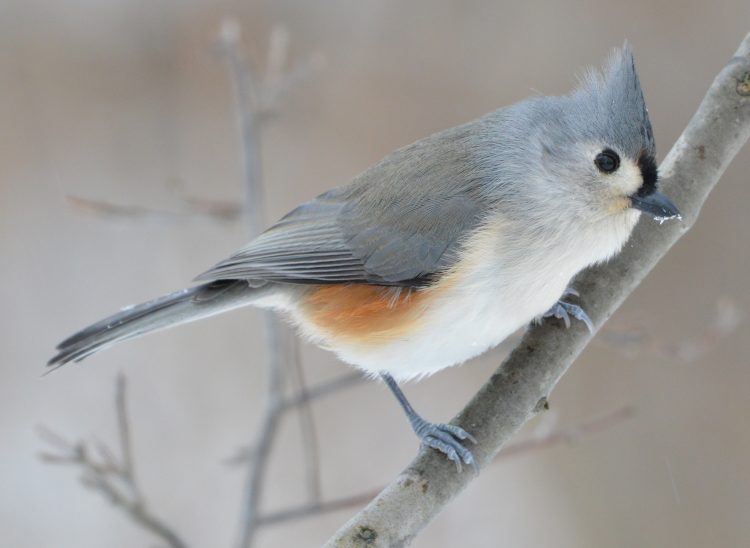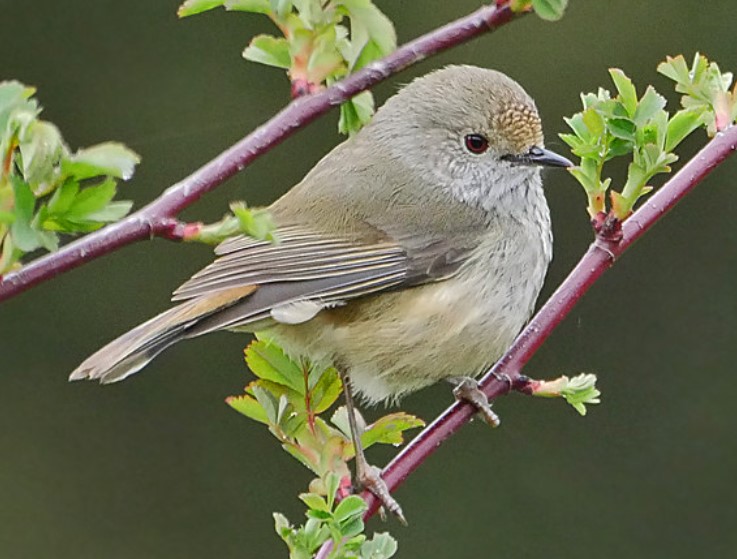The tufted titmouse (Baeolophus bicolor) is a small songbird in the tit and chickadee families (Paridae). The North American bird black-crested titmouse (Baeolophus atricristatus), usually found in central and southern Texas, was included as a subspecies but is now considered a separate species.
Breeding titmice occupy a full spectrum of woodlands, from extensive mature forests to isolated second-growth woodlots with a few large trees. Wooded riparian corridors are equally suitable, while a few pairs find refuge in urban areas within parks, cemeteries, and shaded residential areas. The Tufted Titmouse is a common permanent resident in Tennessee, particularly in wooded areas.
They are regular visitors at feeding stations in many residential sections of Nashville from early autumn until spring if sunflower seeds, nutmeats, peanut butter, or suet are available. Most of them go to the woods in spring to nest. They often return to my home banding station in May, June, or July, bringing their nearly mature fledgling
Measurements
The tufted titmouse length is 14–16 cm, with 20–26 wingspans in length, a white front, and a grey upper body outlined with rust-colored flanks. Moreover, the other characteristics include their black foreheads and the tufted grey crest on their heads.
Tufted titmouse Sounds (Call or Song)
The tufted titmouse sound is usually described as a whistled peter-peter-peter. Nevertheless, this song can vary in approximately 20 notable ways. Immature Tufted Titmice sing lengthy, formless songs, as do many other juvenile birds. After a period of silence or uncommon song in winter, the voice of the Tufted Titmouse is regularly heard by mid-January in loud peto, peto, peto, or peo, peo, peo or a quickly uttered p, p, p, most obstinately by the male when calling for a mate. In February and March, a sibilant sweet, sweet, or see, see, or see-bee (like a Carolina Chickadee song) is also used.
These sibilant notes are heard mostly when a pair is together, sometimes as they feed together, or when the male calls his mate to give her food that he holds in his bill. The male nesting pair used the loud petoo from a distance to call his incubating mate from the nest for food. If she had not joined him, he would have come closer to the nest and used the soft sibilant notes to call her off. After the young hatched when he no longer fed the female, he announced his arrival in the vicinity of the nest with a harsh rasping call, occasionally with a petoo note.
Habitats
The bird habitat is deciduous and mixed woods, as well as gardens, parks, and shrublands. Titmice frequently forage with chickadees and nuthatches, sharing the same wooded habitats as these species. Though this is a non-migratory bird and was originally native to Ohio and Mississippi,. Other factors, such as bird feeders, have caused these birds to occupy a larger amount of territory across the USA and stretch into Ontario, Canada. For the last 50 years, the bird population has increased by more than 1.5% per year throughout the northeastern U.S., Wisconsin, and Michigan.
Titmouse will stash food for later use, and it can demonstrate curiosity regarding humans. It will sometimes perch on a window ledge and seem to be peering into the house. The bird may cling to the windows and walls of buildings, seeking prey in wasp and hornet nests. It is a constant visitor around bird feeders, and its normal pattern is to scout a feeder from cover, fly in to take a seed, then fly back to cover to eat it.
They normally avoid small woodlots of only a few acres in size, narrow wooded corridors along fencerows, and brushy successional habitats. In the non-breeding season. Tufted Titmice are social, flying and feeding amicably together in twosomes, in groups, and in association with the closely related Carolina Chickadee (Parus carolinensis).
Diet or Food
The tufted titmouse gathers food from tree branches and from the ground. The birds tend to like to eat nuts, berries, insects, snails, small fruit, and seeds. However, caterpillars constitute a major part of its diet during the summer. In the winter, Tufted Titmice frequently store food or attempt to do so. One tucked a shelled sunflower seed into a crevice of the bark of a silver maple tree.

Nest:
Nest construction activities are most prominent between mid-March and mid-April. Tufted titmice usually make nests in a tree hole, either a natural cavity, a human-made nest box, or occasionally an old woodpecker nest. The birds sophisticatedly line the nest with soft materials, sometimes plucking hair from a live animal such as a dog. If they find snakeskin shedding, they may incorporate pieces into their nest.
Titmice raises only one brood annually but will re-nest if their first attempt is unsuccessful. Within these wooded habitats, the most critical factor for breeding titmice is the presence of large trees with suitable cavities for nesting. Unlike chickadees, that primarily excavate their own nest holes, titmice prefer natural cavities and abandoned woodpecker holes.
However, some titmice will excavate their own cavities, and a few pairs may occupy birdhouses. Most nests are placed at heights of 10–25 feet, although a few have been found at heights of only 3–5 feet in fence posts, while others may be 40–50 feet above the ground in tall trees.
During egg-laying, it is customary for the female Tufted Titmouse, like the Carolina Chickadee, to cover the incomplete set with nest lining material when she leaves the nest. Nests are usually lined with soft fibers or mammal hair, sometimes sheep wool. This habit tends to protect the eggs, as it gives the impression of an incomplete nest.
Eggs:
Eggs are white or cream-colored with brownish spots and measure under 1 inch long. Most nests with eggs have been discovered in late April and May. The young titmice normally hatch during the second half of May and fledge in June.
Courtship Feeding
Courtship feeding usually starts in March, before nest building. The male uses a sibilant see to make the call to the female, and she assumes the begging posture like a dependent fledgling to solicit or receive the feeding.

Tufted Titmouse Lifespan
Generally, a tufted titmouse lifespan is 2 years; hence, few records are found for more than 10 years. Normally, birds have a clutch size of 5 to 7 eggs. Similar to other birds, the tufted titmouse stays with its parents during the cold winter season. Even after the first year, a bird born the year before will support its parents to raise the next year’s young. Older birds arrived earlier in the fall and departed earlier in the spring. They were also recaptured with decreasing frequency.
History
Tufted Titmice have been expanding northward through the Great Lakes and New England regions since the 20th century. This species has been widely distributed in Ohio since the late 1800s. It had considered them to be common permanent residents throughout the state.
The bird cited breeding records from every county and described their status as common to abundant in most counties, although they were “somewhat less numerous” in the northern third of the state and locally uncommon to rare in northeastern Ohio. Their numbers may have increased within northern Ohio after 1940, as they have become common residents in these counties.
Between 1965 and 1975, their numbers declined on Breeding Bird Surveys in Ohio. However, a trend was accentuated during the severe winters of 1976–1978. Titmice populations quickly recovered after these severe winters, and their numbers have remained reasonably stable since the 1980s. Also, read: Orange Breasted Bunting

Product You May Be Interested in
- Feel Emotional Freedom! Release Stress, Heal Your Heart, Master Your Mind
- 28 Day Keto Challenge
- Get Your Customs Keto Diet Plan
- A fascinating approach to wipe out anxiety disorders and cure in just weeks, to become Anxiety free, relaxed, and happy.
- Flavor Pairing Ritual Supercharges Women’s Metabolisms
- The best Keto Diet Program
- Boost Your Energy, Immune System, Sexual Function, Strength & Athletic Performance
- Find Luxury & Designer Goods, Handbags & Clothes at or Below Wholesale
- Unlock your Hip Flexors, Gives you More Strength, Better Health, and All-Day Energy.
- Cat Spraying No More – How to Stop Your Cat from Peeing Outside the Litter Box – Permanently.
- Anti-aging nutritional unexplained weight gain, stubborn belly fat, and metabolic slowdown. Reach Your Desired Weight in a Week and Stay There.
- Get All Your Healthy Superfoods In One Drink






